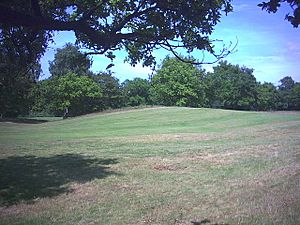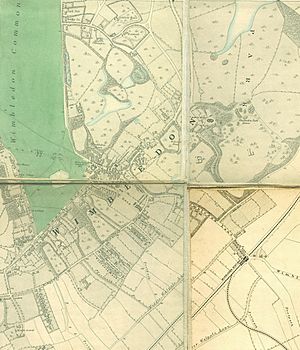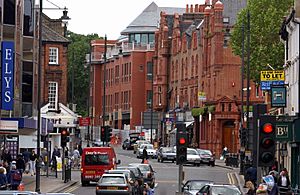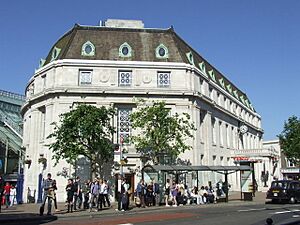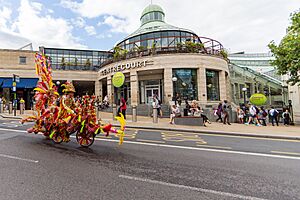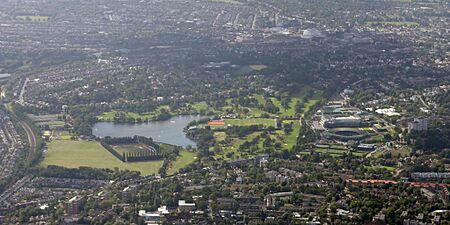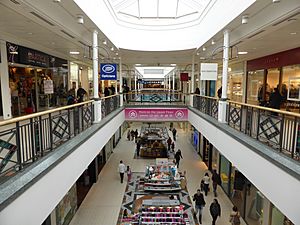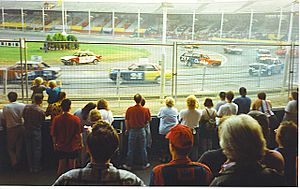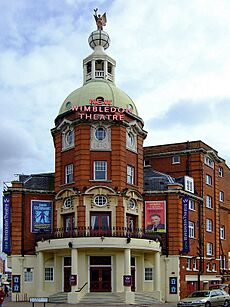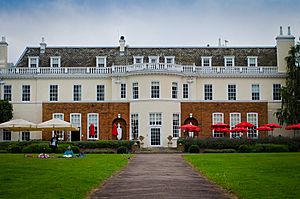Wimbledon, London facts for kids
Quick facts for kids Wimbledon |
|
|---|---|
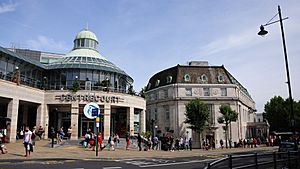 Wimbledon town centre |
|
| Population | 68,187 (2011 Census) |
| OS grid reference | TQ239709 |
| London borough | |
| Ceremonial county | Greater London |
| Region | |
| Country | England |
| Sovereign state | United Kingdom |
| Post town | LONDON |
| Postcode district | SW19, SW20 |
| Dialling code | 020 |
| Police | Metropolitan |
| Fire | London |
| Ambulance | London |
| EU Parliament | London |
| UK Parliament |
|
| London Assembly |
|
Wimbledon (/ˈwɪmbəldən/) is a town in south-west London, England. It is about 11 kilometers (7 miles) southwest of central London. Wimbledon is the main shopping and business area of the London Borough of Merton. In 2011, about 68,187 people lived here.
Wimbledon is famous for the Wimbledon Championships, a major tennis tournament. It also has the New Wimbledon Theatre and Wimbledon Common. The Common is one of the biggest open spaces in London. The town has two main parts: the "village" and the "town." The "village" is the older part, with its High Street built where the medieval village once stood. The "town" grew later, especially after the railway station opened in 1838.
People have lived in Wimbledon since at least the Iron Age. A hill fort was built on Wimbledon Common around that time. In 1086, when the Domesday Book was made, Wimbledon was part of a larger area called Mortlake. Over time, many rich families owned the land here. They built large homes like Eagle House and Wimbledon Manor House.
The village grew with local people living alongside wealthy families from London. In the 1700s, the Dog and Fox pub became a stop for stagecoaches traveling from London to Portsmouth. Then, in 1838, the London and South Western Railway opened a station. This station was southeast of the old village. Its location caused the town to grow more around the new station, away from the original village center.
Wimbledon was a separate town in the county of Surrey from 1905 to 1965. In 1965, it became part of the London Borough of Merton. This happened when Greater London was created. Wimbledon has many different groups of people living there. These include British Asians, British Ghanaians, Poles, and Irish people.
Contents
History of Wimbledon
Early Times
Wimbledon has been lived in for a very long time. An Iron Age hill fort was built on Wimbledon Common. This fort is the second largest in London. The first main part of Wimbledon was at the top of the hill, near the Common. This area is now known as "the village."
The name "Wimbledon" means "Wynnman's hill." The word "dun" means hill in an old Celtic language. The town's name was spelled differently over the years. The current spelling, "Wimbledon," became common in the early 1800s.
Around 1086, Wimbledon was part of the Mortlake area. So, it was not listed separately in the Domesday Book. The ownership of Wimbledon changed many times. The church owned it until 1398. Then, King Richard II took it over.
The land stayed with the King until Henry VIII gave it to Thomas Cromwell. But Cromwell was later executed, and the land went back to the King. Henry VIII's last wife, Catherine Parr, owned it next. After she died, it became royal property again.
In the 1550s, Queen Mary I gave the land to Cardinal Reginald Pole. After his death, Elizabeth I owned it. In 1574, she gave the manor house to Christopher Hatton. He sold it to Sir Thomas Cecil. A new manor house, Wimbledon Palace, was built. Beautiful gardens were also created.
1600s in Wimbledon
Wimbledon was close to London, which attracted rich families. In 1613, Robert Bell built Eagle House. It was an easy distance from London for him. The Cecil family owned the manor for 50 years. Then, King Charles I bought it in 1638 for his wife, Henrietta Maria.
After the King was executed in 1649, the manor had many different owners. But after the King was restored in 1660, it went back to Henrietta Maria.
She sold the manor in 1661 to George Digby, 2nd Earl of Bristol. He hired John Evelyn to make the gardens more modern. After he died, the manor was sold again to Thomas Osborne.
1700s in Wimbledon
The Osborne family sold the manor to Sir Theodore Janssen in 1712. He started building a new house. But his company had big problems, so the house was never finished.
The next owner was Sarah Churchill, Duchess of Marlborough. She bought more land and finished building a house in 1735. When she died, the property went to her grandson, John Spencer.
The village kept growing. In the 1700s, stagecoaches started running from the Dog and Fox pub. This made trips to London easier. But there was a risk of highwaymen robbing the coaches. The horses for the stagecoaches were kept behind the pub. This area is now called Wimbledon Village Stables.
The manor house built in 1735 burned down in the 1780s. A new one, Wimbledon Park House, was built in 1801. At that time, the manor land included Wimbledon Common and the park around the house. This area is now Wimbledon Park.
Wimbledon House was another home near the village. In the 1790s, a French statesman lived there. Later, the mother of writer Frederick Marryat lived there. Nearby roads are named Calonne and Marryat after them. South of the Common, Warren House (now Cannizaro House) was home to many important people.
1800s Development
The early 1800s were quiet for Wimbledon. It was a peaceful countryside area with local people and rich merchants. But things changed in 1838. The London and South Western Railway opened a station. It was built southeast of the village, at the bottom of Wimbledon Hill. This station made the town grow more around it, shifting away from the old village center.
For some years, Wimbledon Park was rented out. In the 1840s, the Spencer family sold the park land for building. Large houses were built in the north of the park. In 1864, the Spencers tried to get permission to build on Wimbledon Common. But permission was denied. Instead, a group was set up in 1871 to protect the Common.
In the second half of the 1800s, Wimbledon grew very fast. The number of people living there increased 15 times in 50 years. Many houses were built along the roads leading to nearby areas.
Transport got even better with more railway lines. The District Railway (now the London Underground District line) also extended its service in 1889.
The town's shops and public services also grew. Ely's department store opened in 1876. Wimbledon got its first police station in 1870. A library opened in 1887. New churches were built as the population grew.
Street names like Denmark Road celebrate events. They mark the marriage of Edward, Prince of Wales, to Princess Alexandra of Denmark.
Wimbledon changed from a village to a small town. This was recognized in 1894. A local council was formed to manage the area.
Modern History
Wimbledon's population kept growing in the early 1900s. In 1905, it became a Municipal Borough. This meant it could have its own mayor.
By 1910, Wimbledon had an art school, its first cinema, and a theatre. In the 1930s, new building slowed down in Wimbledon. Growth shifted to nearby Morden. Wimbledon station was rebuilt in 1930.
In 1931, a new Town Hall was built next to the station. It was made of red brick and stone.
During World War II, many houses in London were damaged. This led to a big building phase in Wimbledon. Many old Victorian houses were turned into flats. Others were knocked down and replaced with apartment blocks. New housing was also built by the council for people who lost their homes.
In the 1970s and 1980s, Wimbledon's town center struggled. It was hard to compete with bigger shopping areas like Kingston. The town needed large stores to attract shoppers. In 1990, the Centre Court shopping center opened next to the station. This helped bring more people to the town. The shopping center included the old town hall building.
Geography of Wimbledon
Wimbledon is in the southwest of London. It is about 5 kilometers (3 miles) south of Wandsworth. The area is known as a wealthy suburb. It has large Victorian houses, modern homes, and apartments.
The town is divided into two parts: the "village" and the "town." The "village" is near the Common. It is centered on the High Street. This part was the original medieval village. It is now a very expensive place to live in London. The "town" is the newer part. It is centered on The Broadway. This area grew after the railway station was built in 1838.
Most adults in Wimbledon are in the ABC1 social group. The population grew from about 1,000 in the early 1800s to around 55,000 by 1911. It has stayed about the same since then.
People of Wimbledon
Wimbledon is covered by several areas called wards. This makes it hard to get exact numbers for the whole town.
Based on the 2011 census, the largest groups of people in the wards (up to 10%) are:
- Village (northern areas and the village): 65% White British, 16% Other White
- Wimbledon Park (north-east): 60% White British, 18% Other White
- Hillside (west of center): 56% White British, 20% Other White
- Dundonald (south of center): 61% White British, 18% Other White
- Raynes Park (west of center): 61% White British, 16% Other White
- Trinity (east from center): 56% White British, 18% Other White
How Wimbledon is Governed
Around 1086, Wimbledon was part of the Mortlake area. From 1328 to 1536, the Archbishop of Canterbury owned the land.
The ownership of Wimbledon changed many times. Wimbledon was an old parish from medieval times. Later, it became the Municipal Borough of Wimbledon in Surrey.
In 1965, the Municipal Borough of Wimbledon was removed. Instead, the London Borough of Merton was created. This new borough included Wimbledon. At first, the main office was in Wimbledon Town Hall. But in the early 1990s, it moved to Morden.
Wimbledon is now in the Wimbledon Parliamentary area. Since 2005, Stephen Hammond from the Conservative Party has been the Member of Parliament (MP).
Since 2005, the north and west of the borough have been represented by Paul Kohler. He is a Liberal Democrat MP. The east and south of the Borough are represented by Siobhain McDonagh. She is a Labour Party MP.
Wimbledon's Economy
In 2012, businesses in Wimbledon voted to create a Business Improvement District. This led to "Love Wimbledon" being formed in April 2012. It is run by local businesses to make the town center better. People who work in Wimbledon can get a 'Privilege Card'. This card gives them discounts in the town center.
Zipcar, a car-sharing company, has its UK main office in Wimbledon. Other important groups with offices here include CIPD and United Response. Lidl also had its UK headquarters here until 2022.
Local News
The Wimbledon Times (which used to be called Wimbledon Guardian) provides local news. You can read it in print or online.
The Tennis Championships
In the 1870s, the All-England Croquet Club held its yearly championships. This was on land near the railway line. But croquet was becoming less popular. A new sport called lawn tennis was growing. The club set aside one lawn for tennis. In July 1877, they held their first Lawn Tennis Championship. By 1922, tennis was so popular that the club's small grounds were too crowded. The club, now called the All England Lawn Tennis and Croquet Club, moved to new grounds near Wimbledon Park.
A local historian, Richard Milward, shared a story about the new courts. King George V opened them. He hit a gong three times, the covers were taken off, the first match started – and then it rained! The club's old grounds are now used as a sports field for Wimbledon High School.
Sports in Wimbledon
Horse Riding
Wimbledon Village Stables is the oldest known riding stables in England. A local historian found records of stables belonging to the Lord of the Manor from 1236–37. The stables at the current site, behind the Dog & Fox pub, started in 1915. They were called Hilcote Stables. Today, they are called Wimbledon Village Stables. They offer horse-riding lessons and rides on Wimbledon Common and in Richmond Park.
Horse Racing
In 1792, a writer named Daniel Lysons wrote about Wimbledon. He said that horse races used to happen on the Common every year. He mentioned a "King's plate" for the winners. But he did not give many details about how popular the races were or how long they lasted.
Football
Wimbledon Football Club was a small team for a long time. But from 1977, they quickly moved up in the football leagues. They reached the top national league in 1986. In 1988, they won the FA Cup against Liverpool.
Wimbledon FC played at a stadium called Plough Lane from 1912 to 1991. Then, they shared a stadium with Crystal Palace in Croydon. This was because their old stadium was not modern enough. The Plough Lane stadium was empty for 10 years. It was finally knocked down in 2001. Now, houses are built on that site.
AFC Wimbledon is a new club started by fans after the old team moved away. They played in Kingston upon Thames for some years. But in 2020, they moved into a new stadium. It is also called Plough Lane. It is very close to where the old stadium used to be.
Motorcycle Speedway
For many years, Wimbledon Stadium hosted Greyhound racing. It also had Stock car racing and motorcycle speedway. Speedway started there in 1928. The local team, the "Dons," were very successful. They raced in the top league for many years. In the 1950s, two World Champions raced for the Dons. The team's last season was in 2005. The stadium was knocked down in 2017.
Running
There are two running clubs in Wimbledon Park. They are called Hercules Wimbledon and the Wimbledon Windmilers. Both clubs have top athletes and beginners. A Parkrun event happens every Saturday morning. Before Parkrun, a similar event called the Wimbledon Common Time Trial was held.
Theatres in Wimbledon
New Wimbledon Theatre
The New Wimbledon Theatre is a beautiful Edwardian theatre. It was built by J. B. Mullholland. The theatre opened on December 26, 1910, with a pantomime show. It was very popular between the two World Wars. Famous actors like Gracie Fields performed there. Big musicals like Oliver! and Half A Sixpence first opened here in the 1960s.
The theatre was saved from being redeveloped in 2004. It has been updated but still has its original fancy features. A golden statue is on the dome. It shows Laetitia, the Roman Goddess of Gaiety. She holds a laurel crown, a symbol of celebration. The statue was removed during World War II. People thought it might help German bombers find their way. It was put back in 1991.
Polka Children's Theatre
The Polka Theatre is a special theatre for children in Wimbledon. It is for kids up to 13 years old. The theatre has two stages. One is a large room with 300 seats. The other is a smaller studio with 70 seats for very young children. Polka also has a learning studio, a garden, and a playground. It is a charity and gets money from the Arts Council England and the London Borough of Merton. The theatre opened in November 1979.
Transport in Wimbledon
Wimbledon has several train and tube stations:
- Wimbledon station
- Wimbledon Chase railway station
- Raynes Park railway station
- Wimbledon Park tube station
- South Wimbledon tube station
National Rail
Wimbledon is in Oyster Fare Zone 3.
| Start | End | Operator | Other Info |
|---|---|---|---|
| London Waterloo | Dorking | South Western Railway | |
| London Waterloo | Epsom | South Western Railway | |
| London Waterloo | Guildford | South Western Railway | |
| London Waterloo | Richmond | South Western Railway | |
| London Waterloo | Hampton Court | South Western Railway | |
| London Waterloo | Shepperton | South Western Railway | |
| London Waterloo | Chessington South | South Western Railway | |
| Luton | Sutton | Thameslink | Only during busy hours |
| Bedford | Sutton | Thameslink | Only during busy hours |
| St Albans City | Sutton | Thameslink | |
| London Bridge | Sutton | Southern |
Bus and Tram
Many London Buses routes serve Wimbledon. These include routes 57, 93, 131, 156, 163, 164, 200, 219, and 493. There is also a night bus, N87. Wimbledon is also served by Tramlink route 3.
Wimbledon in Books
Wimbledon is the main setting for some funny books by author Nigel Williams. These include The Wimbledon Poisoner. It is also where Elisabeth Beresford's children's stories about the Wombles take place.
In H. G. Wells' book The War of the Worlds, one of the alien invasion machines lands in Wimbledon. The town is also mentioned in his books The Time Machine and When the Sleeper Wakes.
Every October, thousands of people go to the Wimbledon BookFest. It has been held since 2006. Over 60 events take place around Wimbledon, including a big tent on the Common.
Famous People from Wimbledon
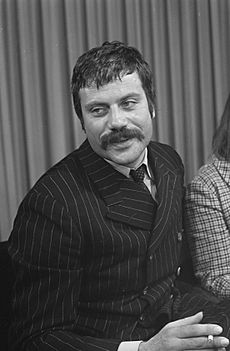
Many famous people have lived in or are from Wimbledon:
- Khalid Abdalla (born 1980), actor
- Ben Barnes (born 1981), actor
- Boris Becker (born 1967), tennis player
- Raymond Briggs (1934–2022), cartoonist
- Sarah Churchill, Duchess of Marlborough (1660–1744), friend of Queen Anne
- Annette Crosbie (born 1934), actress
- Jack Davenport (born 1973), actor
- Sandy Denny (1947–1978), singer
- Laurence Doherty (1875–1919), tennis champion
- Reginald Doherty (1872–1910), tennis champion
- Hugh Dowding (1882–1970), RAF commander in the Battle of Britain
- Sid Field (1904–1950), comedy actor
- Ford Madox Ford (1873–1939), author
- Robert Graves (1895–1985), poet
- Victoria Hamilton (born 1971), actress
- Ted Heath (1902–1969), bandleader
- Georgette Heyer (1902–1974), novelist
- Tom Holland (born 1996), actor
- James Hunt (1947–1993), Formula 1 World Champion
- Sir Theodore Janssen (c.1658–1748), founder of the Bank of England
- Vanessa Kirby (born 1988), actress
- Michael McIntyre (born 1976), comedian
- Marcus Mumford (born 1987), singer from Mumford & Sons
- Horatio, Viscount Nelson (1758–1805), famous admiral
- Oliver Reed (1938–1999), actor
- Margaret Rutherford (1892–1972), actress
- Arthur Schopenhauer (1788–1860), philosopher
- Ridley Scott (born 1937), film director
- Haile Selassie I of Ethiopia (1892–1975), former Emperor of Ethiopia
- Steve-O (born 1974), entertainer
- Jamie T (born 1986), musician
- William Wilberforce (1759–1833), anti-slavery campaigner
- Dame June Whitfield (1925–2018), actress
Places to Visit and Schools
Major Public Open Spaces
- Cannizaro park
- Richmond Park
- Wimbledon Common
- Wimbledon Park
Museums
- Southside House
- Wimbledon Lawn Tennis Museum
- Wimbledon Museum
- Wimbledon Windmill
Schools
- Ricards Lodge High School, Lake Road, Wimbledon (for girls)
- Rutlish School, Watery Lane, Merton Park (for boys)
- Ursuline High School, Crescent Road, Wimbledon (Catholic, for girls)
- Wimbledon College, Edge Hill, Wimbledon (Catholic, for boys)
- Wimbledon High School, Mansel Road, Wimbledon (for girls)
Primary Schools
- Dundonald Primary School
- Garfield Primary School, Garfield Road, Wimbledon (Mixed)
- Hollymount Primary School, Cambridge Road, West Wimbledon (Mixed)
- Holy Trinity Primary School, Church of England, Effra Road, Wimbledon
- St. Mary's Catholic Primary School, Russell Road, Wimbledon
- Wimbledon Chase Primary School, Merton Hall Road, Wimbledon
- Wimbledon Park Primary School, Havana Road, Wimbledon Park
- Bishop Gilpin, Lake Road, Wimbledon Park
Independent Schools
- Donhead Lodge (Boys' School), Edge Hill, Wimbledon
- Ursuline Preparatory School, Wimbledon
- Hall School Wimbledon (Mixed School), The Downs, Wimbledon
- King's College School, Southside, Wimbledon
- The Norwegian School in London, Arteberry Road, Wimbledon
- Wimbledon High School (Girls' School), Mansel Road, Wimbledon
- The Rowans School (Mixed, Primary School), Drax Avenue, Wimbledon
Places of Worship
- All Nations' Church (evangelical), Mansel Rd, SW19
- All Saints' Church, South Wimbledon, SW19
- Bethel Baptist Church, Broadway, SW19
- Wat Buddhapadipa (Buddhist Temple), Calonne Rd, SW19
- Chabad Wimbledon Synagogue, St George's Road, SW19 4ED (Jewish)
- Congregational Church, Dundonald Rd, SW19
- Everyday Church, Queens Road, SW19 8LR
- Christ Church, Colliers Wood, SW19 2NY
- Christ Church, West Wimbledon (Church of England), SW20
- Christian Science Reading Room, Worple Rd, SW19
- Church of Christ the King (Catholic), Crescent Gardens, SW19
- Elim Pentecostal Church, SW19
- Emmanuel Church (Church of England), Ridgway, SW19
- Hillside Church (non-denominational), Worple Rd, SW19
- Holy Trinity Church (Church of England), Broadway, SW19
- Kairos Church (inter-denominational), Kingston Rd, SW19
- Kingdom Hall (Jehovah's Witnesses), Haydons Rd, SW19
- Our Lady and St Peter's Church (Catholic), Victoria Drive, SW19
- Sacred Heart Church (Catholic), Edge Hill, SW19
- St Andrews Church (Church of England), Herbert Rd, SW19
- Saint John the Divine Merton, SW19
- Shofar Christian Church, The Broadway, SW19 1RY
- St John the Baptist (Church of England), Spencer Hill, SW19
- St Luke's Church (Church of England), Ryfold Road, Wimbledon Park SW19 8BZ
- St Mary's Church (Church of England), St Mary's Rd, SW19
- St Winefride's Church, (Catholic), Latimer Rd, SW19
- Salvation Army, Kingston Rd, SW19
- Shree Ghanapathy Temple (Hindu), Effra Rd, SW19
- Wat Buddhapadipa (Buddhist), Calonne Road, SW19
- The Open Door (non-denominational), Worple Rd, SW19
- Trinity United Reformed Church, Mansel Rd, SW19
- The Wimbledon Synagogue (Reform Jewish)
- Wimbledon Mosque (Islam), Durnsford Rd, SW19
- Wimbledon Quaker Meeting, Spencer Hill Rd, SW19
- Wimbledon Spiritualist Church, SW19
See also
 In Spanish: Wimbledon (Londres) para niños
In Spanish: Wimbledon (Londres) para niños



